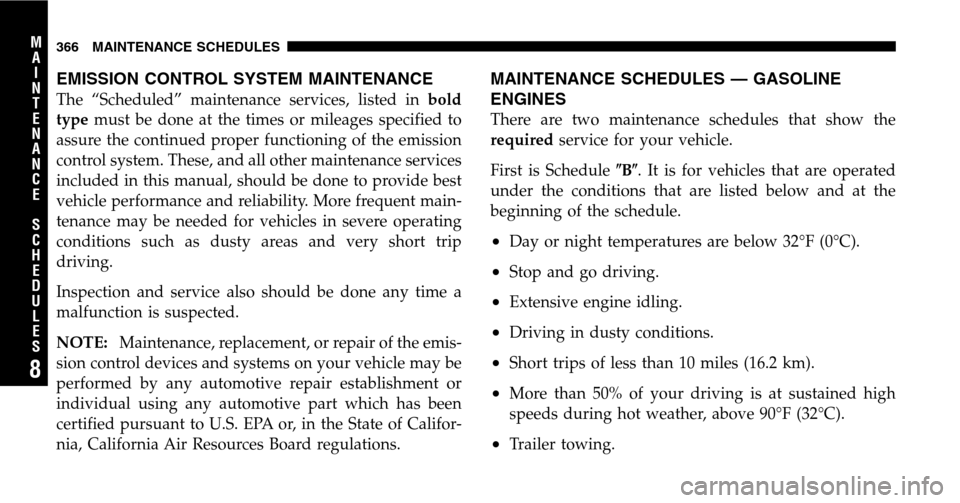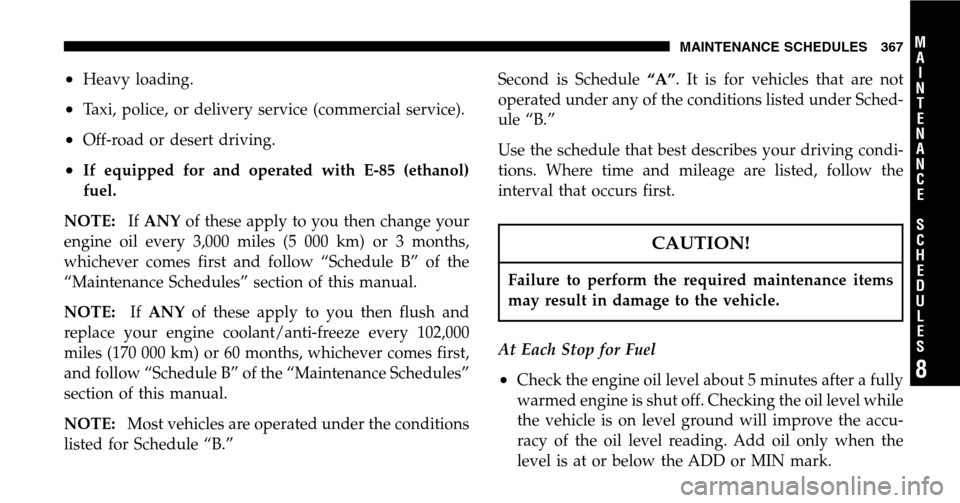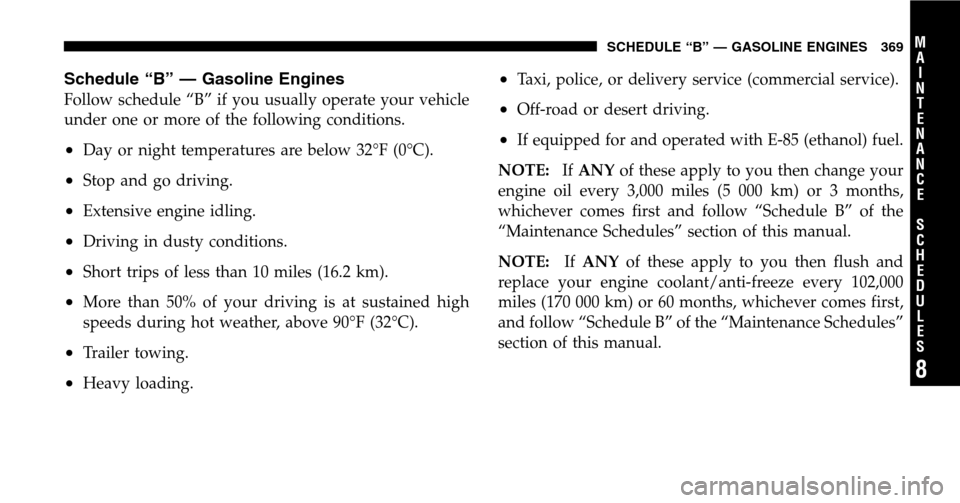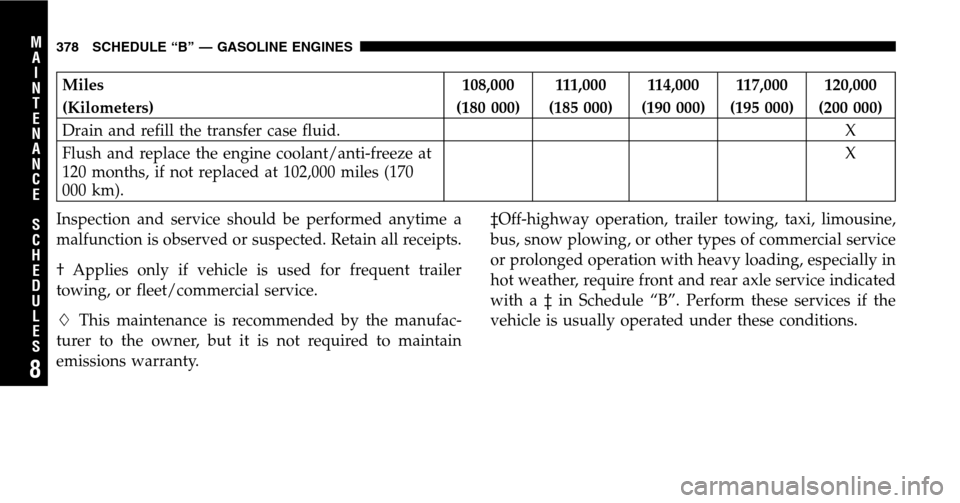Page 338 of 424

Brake and Power Steering System Hoses
When servicing the vehicle for scheduled maintenance,
inspect surface of hoses for evidence of heat and me-
chanical damage. Hard and brittle rubber, cracking, tears,
cuts, abrasion, and excessive swelling suggest deteriora-
tion of the rubber. Particular attention should be made to
examining those hose surfaces nearest to high heat
sources, such as the exhaust manifold.
Inspect all hose clamps and couplings to make sure they
are secure and no leaks are present.
NOTE: Often fluids such as oil, power steering fluid,
and brake fluid are used during assembly plant opera-
tions to ease the assembly of hoses to couplings. There-
fore, oil wetness at the hose-coupling area is not neces-
sarily an indication of leakage. Actual dripping of hot
fluid when systems are under pressure (during vehicle
operation) should be noted before hose is replaced based
on leakage. NOTE:
Inspection of brake hoses should be done when-
ever the brake system is serviced and every engine oil
change.
WARNING!
Worn brake hoses can burst and cause brake failure.
You could have an accident. If you see any signs of
cracking, scuffing, or worn spots, have the brake
hoses replaced immediately.
Brake Master Cylinder
The fluid level in the master cylinder should be checked
when performing under hood services, or immediately if
the “Brake Warning Light” shows system failure.
338 MAINTAINING YOUR VEHICLE
Page 365 of 424
MAINTENANCE SCHEDULES
CONTENTS
�Emission Control System Maintenance ........366
� Maintenance Schedules — Gasoline Engines ....366
▫ Schedule “B” — Gasoline Engines .........369
▫ Schedule “A” — Gasoline Engines .........379 �
Maintenance Schedules — Diesel Engines .....384
▫ Schedule “B” — Diesel Engines ...........386
▫ Schedule “A” — Diesel Engines ...........391
8
M
A I
N T
E
N A
N C E
S
C
H E
D
U L
E
S
Page 366 of 424

EMISSION CONTROL SYSTEM MAINTENANCE
The “Scheduled” maintenance services, listed inbold
type must be done at the times or mileages specified to
assure the continued proper functioning of the emission
control system. These, and all other maintenance services
included in this manual, should be done to provide best
vehicle performance and reliability. More frequent main-
tenance may be needed for vehicles in severe operating
conditions such as dusty areas and very short trip
driving.
Inspection and service also should be done any time a
malfunction is suspected.
NOTE: Maintenance, replacement, or repair of the emis-
sion control devices and systems on your vehicle may be
performed by any automotive repair establishment or
individual using any automotive part which has been
certified pursuant to U.S. EPA or, in the State of Califor-
nia, California Air Resources Board regulations.
MAINTENANCE SCHEDULES — GASOLINE
ENGINES
There are two maintenance schedules that show the
required service for your vehicle.
First is Schedule �B�. It is for vehicles that are operated
under the conditions that are listed below and at the
beginning of the schedule.
•Day or night temperatures are below 32°F (0°C).
•Stop and go driving.
•Extensive engine idling.
•Driving in dusty conditions.
•Short trips of less than 10 miles (16.2 km).
•More than 50% of your driving is at sustained high
speeds during hot weather, above 90°F (32°C).
•Trailer towing.
366 MAINTENANCE SCHEDULES
8
M A I
N T
E
N A
N C E
S
C
H E
D
U L
E
S
Page 367 of 424

•Heavy loading.
•Taxi, police, or delivery service (commercial service).
•Off-road or desert driving.
•If equipped for and operated with E-85 (ethanol)
fuel.
NOTE: IfANY of these apply to you then change your
engine oil every 3,000 miles (5 000 km) or 3 months,
whichever comes first and follow “Schedule B” of the
“Maintenance Schedules” section of this manual.
NOTE: IfANY of these apply to you then flush and
replace your engine coolant/anti-freeze every 102,000
miles (170 000 km) or 60 months, whichever comes first,
and follow “Schedule B” of the “Maintenance Schedules”
section of this manual.
NOTE: Most vehicles are operated under the conditions
listed for Schedule “B.” Second is Schedule
“A”. It is for vehicles that are not
operated under any of the conditions listed under Sched-
ule “B.”
Use the schedule that best describes your driving condi-
tions. Where time and mileage are listed, follow the
interval that occurs first.
CAUTION!
Failure to perform the required maintenance items
may result in damage to the vehicle.
At Each Stop for Fuel
•Check the engine oil level about 5 minutes after a fully
warmed engine is shut off. Checking the oil level while
the vehicle is on level ground will improve the accu-
racy of the oil level reading. Add oil only when the
level is at or below the ADD or MIN mark.
MAINTENANCE SCHEDULES 367
8
M A I
N T
E
N A
N C E
S
C
H E
D
U L
E
S
Page 368 of 424
•Check the windshield washer solvent, add as required.
Once a Month
•Check the tire pressure and look for unusual wear or
damage.
•Inspect the battery, and clean and tighten the terminals
as required.
•Check the fluid levels of the engine coolant/anti-
freeze reservoir, brake master cylinder, and transmis-
sion, and add as needed.
•Check all lights and all other electrical items for correct
operation. At Each Oil Change
•Change the engine oil filter.
•Inspect the exhaust system.
•Inspect brake hoses.
•Check the engine coolant/anti-freeze level, hoses, and
clamps.
•After completion of off-road operation, the underside
of the vehicle should be thoroughly inspected. Exam-
ine threaded fasteners for looseness.
368 MAINTENANCE SCHEDULES
8
M
A I
N T
E
N A
N C E
S
C
H E
D
U L
E
S
Page 369 of 424

Schedule “B” — Gasoline Engines
Follow schedule “B” if you usually operate your vehicle
under one or more of the following conditions.
•Day or night temperatures are below 32°F (0°C).
•Stop and go driving.
•Extensive engine idling.
•Driving in dusty conditions.
•Short trips of less than 10 miles (16.2 km).
•More than 50% of your driving is at sustained high
speeds during hot weather, above 90°F (32°C).
•Trailer towing.
•Heavy loading.
•Taxi, police, or delivery service (commercial service).
•Off-road or desert driving.
•If equipped for and operated with E-85 (ethanol) fuel.
NOTE: IfANY of these apply to you then change your
engine oil every 3,000 miles (5 000 km) or 3 months,
whichever comes first and follow “Schedule B” of the
“Maintenance Schedules” section of this manual.
NOTE: IfANY of these apply to you then flush and
replace your engine coolant/anti-freeze every 102,000
miles (170 000 km) or 60 months, whichever comes first,
and follow “Schedule B” of the “Maintenance Schedules”
section of this manual.
SCHEDULE “B” — GASOLINE ENGINES 369
8
M A I
N T
E
N A
N C E
S
C
H E
D
U L
E
S
Page 378 of 424

Miles 108,000 111,000 114,000 117,000 120,000
(Kilometers) (180 000) (185 000) (190 000) (195 000) (200 000)
Drain and refill the transfer case fluid. X
Flush and replace the engine coolant/anti-freeze at
120 months, if not replaced at 102,000 miles (170
000 km). X
Inspection and service should be performed anytime a
malfunction is observed or suspected. Retain all receipts.
† Applies only if vehicle is used for frequent trailer
towing, or fleet/commercial service.
This maintenance is recommended by the manufac-
turer to the owner, but it is not required to maintain
emissions warranty. ‡Off-highway operation, trailer towing, taxi, limousine,
bus, snow plowing, or other types of commercial service
or prolonged operation with heavy loading, especially in
hot weather, require front and rear axle service indicated
witha‡in Schedule “B”. Perform these services if the
vehicle is usually operated under these conditions.
378 SCHEDULE “B” — GASOLINE ENGINES
8
M
A I
N T
E
N A
N C E
S
C
H E
D
U L
E
S
Page 383 of 424
Miles 108,000 114,000 120,000
(Kilometers) (180 000) (190 000) (200 000)
[Months] [108] [114] [120]
Change the engine oil and engine oil filter. X X X
Rotate the tires. X X X
Inspect the engine air filter element, and replace if necessary. X
Replace the spark plugs. X
Inspect and replace the PCV valve, if necessary. X
Inspect the brake linings. X
Inspect the drive belt and replace as needed. Not required if pre-
viously replaced. XX
Flush and replace the engine coolant/anti-freeze if not done at
102,000 miles (170 000 km). X
Inspect the manual transmission fluid, add as necessary. X
Drain and refill the transfer case fluid. X
Inspection and service should be performed anytime a
malfunction is observed or suspected. Retain all receipts.
This maintenance is recommended by the manufac-
turer to the owner, but it is not required to maintain
emissions warranty.
SCHEDULE “A” — GASOLINE ENGINES 383
8
M A I
N T
E
N A
N C E
S
C
H E
D
U L
E
S